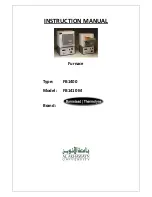
a. Place duct thermometers in return and supply ducts as close
to furnace as possible. Be sure thermometers do not ’see’
heat exchangers so that radiant heat does not affect ther-
mometer readings. This is particularly important with
straight run ducts.
b. When thermometer readings stabilize, subtract return-air
temperature from supply-air temperature to determine tem-
perature rise.
If the temperature rise is outside this range, check the following:
a. Gas input for low- and high gas heat operation.
b. Derate for altitude if applicable.
c. Return and supply ducts for excessive restrictions causing
static pressures greater than 0.50-in. wc.
d. Adjust temperature rise by adjusting blower speed. In-
crease blower speed to reduce temperature rise. Decrease
blower speed to increase temperature rise.
ELECTRICAL SHOCK HAZARD
Failure to follow this warning could result in personal injury
or death.
Disconnect 115-v electrical power before changing speed tap.
.
For high-heat, the following connections can be made at HI HEAT
on control:
a. Med-high (Yellow)
b. Med (Orange) -Available only on 5-speed motors. Factory
setting for these motors.
c. Med-Low (Blue) - Do NOT use for HI GAS-HEAT on
80K & 120K Btuh input models. Factory setting for
4-speed motors.
UNIT DAMAGE HAZARD
Failure to follow this caution may result in damage to the heat
exchangers due to over temperature or condensate corrosion.
1. NEVER connect Low Speed (Red) wire to
″
HI HEAT
″
.
2. Do NOT connect Medium Low Speed (Blue) wire to
″
HI
-HEAT
″
on 80,000 Btuh and 120,000 Btuh input model sizes.
For low-heat, the following connections can be made at LO
-HEAT on control:
a. Med (Orange) -Available only on 5-speed motors
b. Med-Low (Blue)
c. Low (RED) - Factory setting.
To change blower motor speed selections for heating mode,
remove blower motor lead from control HI-HEAT terminal. (See
Fig. 32.) Select desired blower motor speed lead from one of the
other motor leads and relocate it to HI-HEAT terminal. See Table
13 for lead color identification. Reconnect original lead on SPARE
terminal. Follow this same procedure for proper selection of
LO-HEAT and COOL speed selection.
Set Blower Off Delay
a. Remove Blower Access Door if installed.
b. Turn Dip switch 2 and 3 ON or OFF for desired blower off
delay. See Table 9A and B or Fig. 31 and 32.
ADJUST BLOWER OFF DELAY (HEAT MODE)
If desired, the main blower off time delay period may be
lengthened or shortened when operating in the heating mode to
provide greater comfort. See Table 9 for position of switches and
Fig. 31 or 32 for location of switches on control center.
SET THERMOSTAT HEAT ANTICIPATOR
When using a nonelectronic thermostat, the thermostat heat-
anticipator must be set to match the amp draw of the electrical
components in R-W/W1 circuit. Accurate amp draw readings can
be obtained at thermostat subbase terminals R and W.
Fig. 56 illustrates an easy method of obtaining actual amp draw.
The amp reading should be taken after blower motor has started
and furnace is operating in low heat. To operate furnace in
low-heat, first move SW-1 to ON position, then connect ammeter
wires as shown in Fig. 56. The thermostat anticipator should NOT
be in the circuit while measuring current. If thermostat has no
subbase, the thermostat must be disconnected from R and W/W1
wires during current measurement Return SW-1 to final desired
location after completing the reading.
See thermostat manufacturer’s instructions for adjusting heat
anticipator and for varying heating cycle length.
When using an electronic thermostat, set cycle rate for 3 cycles per
hour.
Step 6—Check Safety Controls
This section covers the safety controls that must be checked before
the installation is complete. The flame sensor, gas valve, and
pressure switch were all checked in the Start-up procedure section
as part of normal operation.
1. Check Primary Limit Control
Table 13–Speed Selection
LEAD COLOR
SPEED
AS SHIPPED
White
Common
C
OM
Black
High
Cool
Yellow
Med-High
SPARE
Orange†
Med
High-Gas Heat
Blue
Med-Low
Spare/High-Gas Heat
Red
Low*
Low-Gas Heat
* Continuous blower speed
† Available on 5-speed blowers only
Fig. 56—Amp Draw Check with Ammeter
A80201
R
Y W G
10 TURNS
THERMOSTAT SUBBASE
TERMINALS WITH
THERMOSTAT REMOVED
HOOK-AROUND
VOLT/AMMETER
EXAMPLE:
5.0 AMPS ON AMMETER
10 TURNS AROUND JAWS
= 0.5 AMPS FOR THERMOSTAT SETTING
FROM UNIT 24-VOLT
TERMINAL BLOCK
49
→
→




































